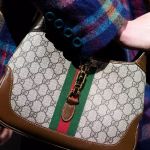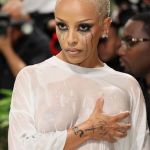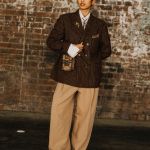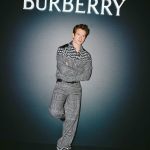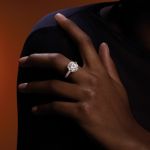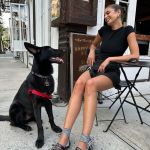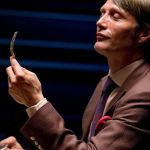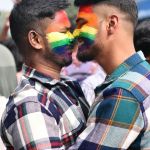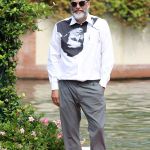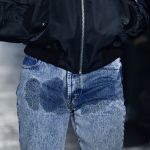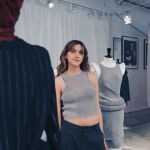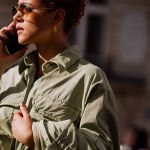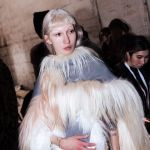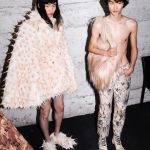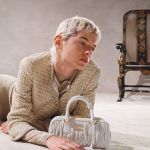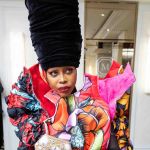
The story of Erykah Badu's hats
How the queen of R&B found her look
May 8th, 2024
On the occasion of the 2024 Met Gala, Erykah Badu was dressed by a brand that isn't usually very present on the red carpet, Comme des Garçons, with a look seen on the brand's SS24 runway, which, in addition to the shoes, had a single difference from the original version: a tall black headdress that wrapped around the singer's neck, halfway between a turban and a top hat. This headdress was something original – but its silhouette has become in recent years Badu's most recognizable signature – whose personal style, starting from her debut in the '90s, is so personal, recognizable, and versatile at the same time that we could define, paraphrasing the expression coined by her and D'Angelo's manager Kedar Massenburg, the Neo-Soul. The name is obviously something generic and indicates the liveliness and originality of Badu's outfits which, over time, have included extremely high boots, pointed sneakers, dresses made entirely of buttons, a myriad of oversized jewelry as well as capes, cloaks, and dresses too avant-garde to be described with simple words. In the midst of so much experimentation (and Badu is perhaps the most experimental artist around in terms of style), the singer's headdresses have become one of the essential parts of her silhouette – so much so that Badu herself frowned quite a bit when, in July of last year, Beyoncé wore a similar tall silver hat to hers for the Renaissance tour. "I guess I'm everybody’s stylist," Badu wrote pointedly at the time. But how did the association between Erykah Badu and her hats come about?
Erykah Badu insinuates that Beyoncé is copying her tour looks:
— Pop Base (@PopBase) July 31, 2023
“I guess I’m everybody stylist” pic.twitter.com/D1nqIVMgVI
Born in Dallas, Texas, Badu was heavily influenced by the soul and hip-hop of the '80s. After enrolling at Grambling State University, she left her studies in 1993 to pursue her musical passions. The following year, she opened for D'Angelo, one of the most important neo-soul artists of the '90s, impressing industry insiders enough to secure her first record deal. In 1997, the twenty-five-year-old Badu made her appearance on BET's Planet Groove, a television show that attracted some of the biggest hip-hop and R&B stars of the '90s. For her appearance, she was already wearing a gold turban, lit candles, and drank herbal tea while talking about her beginnings. A week later, her debut album Baduizm was released (the first single had been released in December '96), became triple platinum, paving the way for four Grammy wins. Needless to say, the album cover shot by Marc Baptiste portrayed Badu with a camouflage turban, and she wore one in practically every public appearance, cultivating a style that mixed Western and American fashion, paying homage to the singer's African roots but also her inclination towards spirituality, following in the footsteps of great artists like Nina Simone or Alice Coltrane. In '98, in addition to winning her first Grammys, Badu appeared on the famous children's program Sesame Street wearing a patchwork turban that from then on became increasingly associated with her, which also returned in her first shoot for Vogue in 1999, where she wore a look by Rodney Epperson. At the time, Badu only wore "black designers from New York, Dallas or Atlanta," as she told Vogue.
However, the following year was the last year Badu wore the turban. In 2000, Badu was engaged to Lonnie Rashid Lynn, aka Common, and they went to Cuba together where the singer decided to delve into her interests in Santeria by consulting a famous local priest. Going to the meeting dressed entirely in white and with her turban, Badu found herself waiting alongside a man smoking cigarettes, with dirty nails, and old Puma Suede shoes that had once been blue. As she recounted to Essence, only shortly after entering for her meeting, Badu realized that that man was the priest: "I never wore the head wrap again. I realized it wasn’t necessary anymore because after all that man was from a long line of healers and he didn’t have to look like one. He was born with it. No matter what he did or what he said no one could take that away from him. That’s when I I got freer and began to evolve. Bean to focus on being more in here than out here." Returning to the subject, Badu added that "as much as I appreciated it, it kind of made me feel trapped a little bit. I became the incense [and] candles poster child." And as early as the 2001 Grammys, the surprise came: Badu showed up completely shaved, inaugurating a phase of experimentation in which her now famous hats would be introduced.
SINGER ERYKAH BADU IN #GIVENCHY HAUTE COUTURE CUSTOM MADE OUTFIT AT THE MET BALL 2014. pic.twitter.com/cfAJ57B70s
— Givenchy (@givenchy) May 6, 2014
Scrolling through the images of that period, without claiming to make a scientific review, it is noticeable that the hats were very different from each other: ranging from the white cylinder to the straw hat, from the wool cap, from Kangol-style bucket hats to fedoras and oversized felt bowler hats. However, the feeling is that the use of these large hats to define the silhouette of their looks became more frequent and consolidated in the second half of the decade – which also marked the period in which Badu truly experimented with all the possible paths her style could follow, demonstrating remarkable eclecticism and personal styling skills. Years passed and the hats ("They're all crowns of some sort" she once said to InStyle) which in the meantime became increasingly larger, but if we wanted to fix a point in the timeline where the mega-hat became Badu's signature, we could perhaps indicate the 2014 Met Gala, where the singer arrived on the red carpet with Riccardo Tisci who, at the height of his glorious Givenchy era, made her wear a black dress with a long white jacket studded with crystals, a huge and tall coordinated hat (resembling the tall bowlers of Bolivian cholitas) with two huge diamond earrings. The look caused a stir also because Badu wore it, along with a turban and a top hat, in the SS14 Givenchy campaign marking her successful landing in the fashion world. Especially since in the same year, at the Grammys, Pharrell wore his now famous Vivienne Westwood hat similar to that of Canadian park rangers, creating, in the pages of newspapers, several comparisons between him and Badu – who was already perhaps "everybody’s stylist" back then without knowing it.
Since around 2017, at least a dozen of Badu's hats have come from a Tokyo-based artisan workshop called Bona Capello founded by designer Thom O’Brien – continuing the singer's passion for supporting independent brands. For the 2021 Met Gala, Badu returned to the classic top hat by Thom Browne, while more recent is the encounter with Francesco Risso of Marni, who accompanied the singer as his guest at the 2022 Met Gala, creating for her a coordinated patchwork dress and hat. The collaboration not only repeated for the 2023 Met Gala (this time without hats) but also expanded when Francesco Risso and Badu announced the imminent release of a collaborative capsule collection that also included several hats. But the biggest hat of all, at least it seems to us the biggest, Badu wore it always for Marni but last September, at the brand's SS24 show in Paris, where the singer was sitting front row in a yellow checkered suit and a sort of huge mohair cylinder with black polka dots that rivaled with the similar and huge hat, this time treated in a way to appear made of oxidized metal, with which Badu showed up at the SS24 show by Bottega Veneta. One can only wonder who will tailor her next but what is certain is that in life you don't need a big hat, but a great hat.









